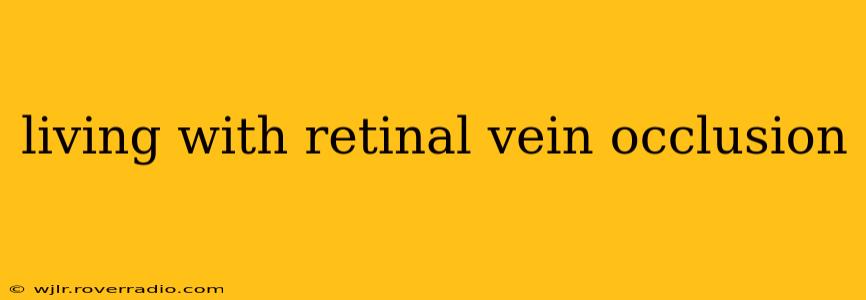Retinal vein occlusion (RVO) is a serious eye condition affecting the retina's blood vessels. Understanding this condition, its management, and how to live with it is crucial for maintaining your vision and overall well-being. This comprehensive guide explores various aspects of living with RVO, offering insights and practical advice.
What is Retinal Vein Occlusion (RVO)?
Retinal vein occlusion occurs when a retinal vein is blocked, preventing blood flow to the retina. This blockage causes retinal swelling and damage, potentially leading to vision loss. There are two main types: branch retinal vein occlusion (BRVO) which affects a branch of the retinal vein, and central retinal vein occlusion (CRVO) which affects the main retinal vein. The symptoms and severity can vary depending on the type and location of the occlusion.
What are the Symptoms of RVO?
Symptoms can develop gradually or suddenly, depending on the severity of the blockage. Common symptoms include:
- Blurred vision: This is often the most noticeable symptom and can affect one eye or both.
- Floaters: These are small spots or specks that appear to float in your vision.
- Vision loss: This can range from mild to severe, depending on the extent of the blockage and the resulting damage to the retina.
- Changes in color vision: You may notice a distortion or fading of colors.
It's crucial to seek immediate medical attention if you experience any of these symptoms. Early diagnosis and treatment can significantly improve the chances of preserving vision.
How is RVO Diagnosed?
Diagnosis typically involves a thorough eye examination by an ophthalmologist. This may include:
- Visual acuity test: To assess your level of vision.
- Ophthalmoscopy: Using an ophthalmoscope to examine the retina directly.
- Fluorescein angiography: This involves injecting a dye into your vein to visualize blood flow in the retina.
- Optical coherence tomography (OCT): This imaging technique provides detailed cross-sectional images of the retina.
What are the Treatment Options for RVO?
Treatment aims to reduce swelling, improve blood flow, and prevent further vision loss. Options may include:
- Intravitreal injections: Injections of medications, such as anti-VEGF drugs (vascular endothelial growth factor inhibitors) into the eye to reduce swelling and prevent the growth of new blood vessels.
- Laser photocoagulation: This procedure uses a laser to seal off leaky blood vessels, reducing swelling and bleeding.
- Eyeglasses or contact lenses: To correct any refractive errors and improve visual acuity.
- Lifestyle modifications: Such as managing blood pressure, cholesterol levels, and diabetes, if present.
How Can I Manage My RVO?
Living with RVO requires a proactive approach to managing the condition and protecting your vision. This includes:
- Regular eye exams: Follow your ophthalmologist's recommendations for regular check-ups.
- Medication adherence: Strictly follow your prescribed medication regimen.
- Lifestyle changes: Maintain a healthy lifestyle by managing risk factors such as high blood pressure, diabetes, and high cholesterol. Quitting smoking is crucial.
- Stress management: Stress can exacerbate certain conditions. Explore relaxation techniques to manage stress effectively.
- Support groups: Connecting with others who have RVO can provide emotional support and practical advice.
What are the Long-Term Outlook and Complications of RVO?
The long-term outlook for RVO varies depending on the severity of the condition and the response to treatment. Some individuals may experience a complete recovery of vision, while others may have permanent vision loss. Potential complications include:
- Macular edema: Swelling of the macula, the central part of the retina responsible for sharp vision.
- Neovascularization: The growth of abnormal blood vessels, which can lead to bleeding and scarring.
- Glaucoma: Increased pressure within the eye.
How Does RVO Affect Daily Life?
The impact of RVO on daily life depends on the severity of vision loss. Some individuals may experience minimal disruption, while others may need adjustments to their daily routines. These adjustments might include:
- Driving limitations: Driving may be restricted or require special accommodations.
- Occupational changes: Some individuals may need to change jobs or modify their work responsibilities.
- Assistive devices: Magnifiers, large-print books, and screen readers may be necessary.
What are the Risk Factors for Developing RVO?
Several factors increase the risk of developing RVO, including:
- High blood pressure: Uncontrolled hypertension significantly increases risk.
- Diabetes: Diabetic retinopathy is a frequent cause of vessel blockage.
- High cholesterol: High levels of LDL cholesterol contribute to vascular damage.
- Glaucoma: Existing glaucoma further elevates the risk.
- Age: RVO is more common in older adults.
- Smoking: Smoking is a major risk factor for vascular diseases, including RVO.
- Obesity: Maintaining a healthy weight reduces the risk of vascular problems.
This information is for educational purposes only and should not be considered medical advice. Always consult with your ophthalmologist or healthcare provider for diagnosis and treatment of retinal vein occlusion. Early detection and proper management are essential for preserving vision and improving your quality of life.
